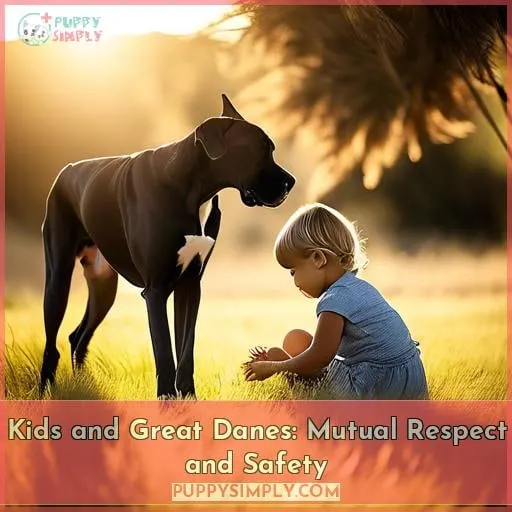This site is supported by our readers. We may earn a commission, at no cost to you, if you purchase through links.

Despite their towering stature, these gentle giants often prove to be loving, patient, and protective companions.
But, like any family addition, there’s more to consider.
From understanding their temperament to their health needs, this guide will help you decide if a Great Dane is the right fit for your family, ensuring a harmonious, safe, and joyful environment for everyone involved.
Table Of Contents
- Key Takeaways
- Understanding Great Dane Size and Temperament
- Training Great Danes for a Family Environment
- Kids and Great Danes: Mutual Respect and Safety
- Great Dane Health Considerations
- Nutritional Needs of Great Danes
- Grooming and Shedding in Great Danes
- Making the Decision: is a Great Dane Right for Your Family?
- Frequently Asked Questions (FAQs)
- What specific steps can parents take to teach their children to interact safely with a Great Dane?
- How can a family with multiple pets ensure a Great Dane will integrate well?
- What are some signs of common health issues in Great Danes that parents should be aware of?
- How can families adjust a Great Dane’s diet to support their health and longevity?
- What are some effective strategies for managing a Great Dane’s shedding in a household with children?
- Conclusion
Key Takeaways
- Supervise all interactions between Great Danes and children due to the risk of accidental injuries from the dog’s large size and strength.
- Start training a Great Dane early and involve the whole family to instill good manners and obedient, kid-friendly behaviors.
- Address potential Great Dane health issues proactively through proper diet, exercise, and vet care to ensure a long, healthy life.
- Groom a Great Dane regularly with brushing and bathing to reduce shedding and promote the dog’s coat health.
Understanding Great Dane Size and Temperament
As you consider adding a Great Dane to your family, it’s important to understand their unique characteristics, especially if you have children.
These gentle giants stand tall and can weigh up to 175 pounds, making their size a factor to be mindful of around kids.
Despite their imposing stature, Great Danes are known for their calm and affectionate temperament, often seeking out cuddles and acting as loyal protectors of their family.
With their patient and loving nature, they can be fantastic companions for children when interactions are supervised to ensure safety for all.
The Gentle Giant Nature of Great Danes
Why should you consider a Great Dane’s size and temperament when assessing their compatibility with children?
Great Danes, known as gentle giants and nanny dogs, offer unique benefits but require careful consideration.
Understanding Socialization: Essential for a harmonious relationship, ensuring your dog is comfortable around kids.
Handling Stubbornness: Promotes obedience, making interactions safer.
Ensuring Supervision: Prevents accidents given their giant breed size.
Great Danes’ Interaction With Kids
Understanding the interaction between Great Danes and kids:
Despite their large size, these gentle giants are generally very good with children.
Their size and energy can sometimes lead to accidental knock-overs, making supervision essential.
Encouraging safe play and establishing clear interaction guidelines fosters a mutual understanding.
Ensuring kid-friendly behaviors from both parties for a harmonious family environment.
Training Great Danes for a Family Environment
As you welcome a Great Dane into your family, it’s crucial to start their training early.
Use positive reinforcement to foster a bond of trust and respect.
You’ll find that your gentle giant is eager to please, especially when rewarded with treats or praise for their good behavior.
It’s important to involve the whole family in the process to ensure your Great Dane becomes a well-mannered member of your household.
Importance of Early Socialization
You’ll need to start socializing your Great Dane early to ensure they’re comfortable and well-behaved around your family and others.
Early exposure to various people, pets, and environments plays a crucial role in their behavioral development.
This foundation of social skills fosters a well-adjusted canine companion, highlighting the importance of early socialization for their overall health and happiness in your home.
Positive Reinforcement Training Techniques
Building on the importance of early socialization, it’s crucial to transition smoothly into using positive reinforcement training techniques to shape your Great Dane’s behavior in a family environment.
- Reward your Dane for obedience with treats or praise, reinforcing good behavior.
- Use behavioral conditioning to teach patience, especially around active toddlers.
- Implement dog training techniques that encourage their intelligent problem-solving.
- Keep sessions short and engaging to maintain their attention.
- Consistently practice commands to foster a well-mannered family companion.
Kids and Great Danes: Mutual Respect and Safety
When introducing your children to a Great Dane, it’s crucial to teach them how to interact with such a large dog safely.
You’ll need to supervise their playtime closely to ensure it’s gentle and respectful, as Great Danes can unintentionally knock over a small child.
By fostering mutual respect and understanding between your kids and your Great Dane, you’ll create a safe and harmonious environment for everyone.
Teaching Kids Safe Interaction With Great Danes
While training your Great Dane is crucial for a harmonious family environment, it’s equally important to teach your children the right way to interact with these gentle giants to ensure mutual respect and safety.
Encourage kids’ involvement in positive reinforcement techniques, emphasizing gentle handling and clear boundaries.
This approach fosters a safe bond between your pet and family, respecting the breed’s nature as a loyal guard dog with a shorter lifespan.
Supervision During Playtime
In playtime with Great Danes and kids, it’s crucial that you’re always present to supervise and ensure safety for both parties.
Given their size, Great Danes can unintentionally knock over a child during rough play.
Monitoring behavior helps prevent accidents and potential health issues like hip dysplasia.
Great Dane Health Considerations
As a parent, it’s crucial to understand the health considerations of owning a Great Dane.
These gentle giants are prone to certain health issues due to their size, such as bloat and joint problems.
Ensuring they maintain a healthy diet, get regular exercise, and receive routine veterinary care can help mitigate these risks and contribute to a happier, healthier life for your Great Dane.
Common Health Issues in Great Danes
As a Great Dane owner, you should be aware that these gentle giants are prone to several health issues, including bloat and hip dysplasia, which require vigilant care and prevention strategies.
Hip Dysplasia Management:
- This condition is common in large breeds like Great Danes.
- Regular vet check-ups, maintaining a healthy weight, and providing a diet rich in glucosamine can help manage this condition.
Gastric Dilatation Prevention:
- Great Danes are particularly susceptible to bloat.
- Feeding smaller meals and avoiding rapid eating can help prevent this life-threatening condition.
Wobbler Syndrome Awareness:
- This neurological condition, characterized by neck pain and an unsteady gait, is linked to nutrition.
- Feeding a quality large-breed puppy diet until 18 months can minimize the risk.
Preventive Measures for Great Dane Health
To safeguard your Great Dane’s health, you’ll need to take proactive steps against common breed-specific issues, such as bloat and joint problems.
Establish a consistent exercise regimen and make dietary adjustments to support joint health.
Regular veterinary consultations can catch issues early, and lifestyle modifications, along with preventive medications, are key to your gentle giant’s well-being.
| Prevention Area | Strategy | Benefit |
|---|---|---|
| Diet | Smaller, frequent meals | Reduces bloat risk |
| Exercise | Regular, gentle workouts | Supports joint health |
| Health Care | Routine vet visits | Early problem detection |
Nutritional Needs of Great Danes
As you consider the well-being of your Great Dane, it’s essential to recognize how their diet impacts their overall health.
Proper nutrition is key to preventing common health issues like bloat and joint problems, which are prevalent in this giant breed.
By feeding your Great Dane a balanced diet tailored to their specific needs, you’ll support their growth and vitality, ensuring they’re a happy and healthy companion for your kids.
Feeding Guidelines for Great Danes
How can you ensure your Great Dane’s diet supports their health and complements the preventive measures discussed previously?
You’ll want to provide meals that are balanced and appropriate for their life stage and energy needs, typically including high-quality protein, healthy fats, vitamins, minerals, and fiber from vegetables and berries.
Large breed nutrition emphasizes the importance of meal frequency to prevent bloat, with dietary considerations tailored to support joint health during all growth stages.
Role of Nutrition in Great Dane Health
Proper nutrition plays a pivotal role in ensuring the health and longevity of Great Danes, particularly given their susceptibility to certain health conditions.
You’ll need to carefully select their diet to support:
- Their massive size
- Rapid growth as puppies
- Prevention of common health issues such as joint problems and bloat
Consider:
- Their growth stages
- Dietary balance for digestive health
- Weight management
- Joint health
Grooming and Shedding in Great Danes
When it comes to managing your Great Dane’s shedding and maintaining their coat, regular grooming practices are key.
Great Danes are moderate to heavy shedders, but their short coats make grooming tasks more manageable.
Incorporating routine brushing into your Great Dane’s care can significantly reduce the amount of hair around your home and keep their coat healthy.
This approach not only helps in controlling shedding but also strengthens the bond between you and your gentle giant.
Managing Great Dane Shedding
After ensuring your Great Dane’s nutritional needs are met, it’s important to turn your attention to their grooming needs, particularly their shedding.
Regular brushing is key to managing this moderate shedding breed. A slicker brush or deshedding tool used weekly can significantly reduce loose fur around your home.
Vacuuming tips include investing in a powerful vacuum or an automated floor cleaner to keep your living spaces fur-free.
For allergy management, consider hypoallergenic shampoos and regular cleaning to minimize dander.
Skin and fur care can be enhanced with supplements like Omega oils, which support a healthy coat and may reduce shedding.
Regular Grooming Practices for Great Danes
Consistency in grooming practices is key to maintaining your Great Dane’s short coat and overall skin health.
Regular brushing, at least once a week, helps manage shedding by removing loose fur and distributing natural oils, promoting a healthy coat.
Bathing frequency varies; every 6-8 weeks is generally sufficient, depending on your Dane’s lifestyle and activity level, to keep their skin healthy without stripping natural oils.
Ear cleaning should be done carefully to prevent infections, using a gentle solution and cotton swabs to clean the visible part of the ear canal.
These grooming practices not only keep your Great Dane looking their best but also strengthen the bond between you and your gentle giant.
Making the Decision: is a Great Dane Right for Your Family?
When considering adding a Great Dane to your family, it’s essential to evaluate your lifestyle and environment.
These gentle giants are known for their affectionate nature and patience with children, but their large size means they need space and supervision to ensure safety for all.
It’s important to align your expectations with the reality of living with a Great Dane, as their presence in a household goes beyond just their calm demeanor.
Consistent training and socialization are key to a harmonious home.
Assessing Your Family’s Lifestyle and Environment
Before deciding if a Great Dane is the right addition to your family, it’s crucial to evaluate:
- Your living space: Does it have ample space for a large dog?
- Daily routine: Do you have time for regular exercise and companionship?
- Ability to meet the breed’s needs: Are you prepared for consistent child supervision and lifestyle compatibility?
Consider:
- Home environment: Great Danes thrive with companionship and regular exercise.
- Family activities: Ensure lifestyle compatibility and commit to consistent child supervision.
Expectations Vs Reality: Living With a Great Dane
Often, you’ll find that living with a Great Dane is a unique experience that requires adjustments to your daily routine and lifestyle.
Expectations of a gentle giant may meet the reality of their imposing size, bringing both adaptation and challenges.
Integrating such a large dog into your family dynamics calls for a lifestyle shift, ensuring everyone’s safety and the dog’s well-being.
Frequently Asked Questions (FAQs)
What specific steps can parents take to teach their children to interact safely with a Great Dane?
Teach your kids to respect the Great Dane’s size and strength.
Show them how to:
- Approach the dog gently.
- Avoid rough play.
- Not disturb the dog while it’s resting.
- Not pull on the dog’s ears or tail.
Always supervise their interactions with the dog.
Consult a professional trainer if needed.
How can a family with multiple pets ensure a Great Dane will integrate well?
Rome wasn’t built in a day, and neither is a harmonious multi-pet household.
Start by introducing your Great Dane to other pets in a neutral space, ensuring all animals are calm.
Use positive reinforcement to reward peaceful interactions.
Always supervise their time together to prevent any misunderstandings.
What are some signs of common health issues in Great Danes that parents should be aware of?
Watch for symptoms like:
- Stomach bloating
- Reluctance to rise
- Rapid eating
- Neck pain
- Unsteady movement
These could indicate serious conditions like bloat, hip dysplasia, or spinal issues.
Schedule regular veterinary checkups to monitor your Great Dane’s health.
How can families adjust a Great Dane’s diet to support their health and longevity?
Feed your Great Dane multiple smaller meals per day of a large breed puppy formula.
Continue this diet until 18 months old to promote bone and joint health.
Monitor weight, as obesity risks conditions like lumbosacral stenosis.
What are some effective strategies for managing a Great Dane’s shedding in a household with children?
Brush weekly and vacuum often.
Bathe every 4-6 weeks with a mild shampoo.
Consider air purifiers and washing bedding frequently.
Limit time spent on furniture and invest in covers.
Daily brushing when shedding is heavy helps control loose hair.
Staying on top of grooming will benefit the whole family.
Conclusion
FYI, deciding if Great Danes are good with kids requires a blend of knowledge and intuition.
These gentle giants, with their loving nature, can indeed become a child’s best friend, given the right training and environment.
Early socialization, positive reinforcement, and teaching mutual respect ensure a safe and joyful relationship.
So, if your family’s ready for the commitment, a Great Dane might just be the perfect addition to your household.













